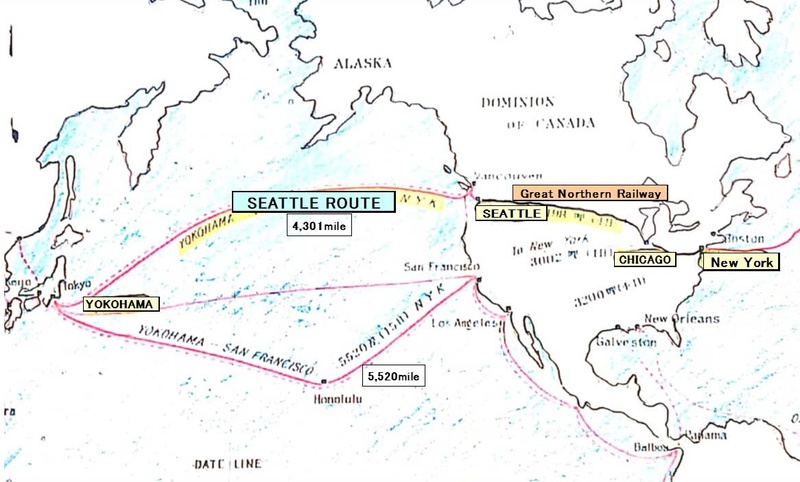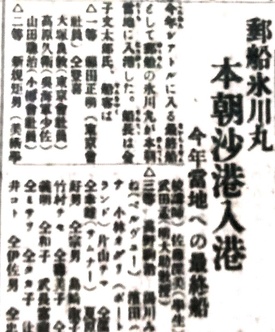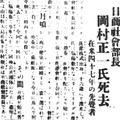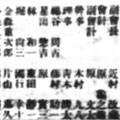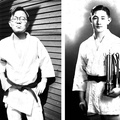In the last chapter, I introduced some articles on the opening of Seattle Route and Seattle Route and the transcontinental railroad around 1918. This time, I will talk about the development of Seattle Route beginning in 1919.
THE SHORTEST INTERNATIONAL OCEAN ROUTE
“Japan-US Ocean Route and European Ocean Route” (From the Mar. 8, 1919 issue)
“In Japan, traveling to Europe and/or the U.S. has become a craze after the (World War I) cease-fire, whether it’s for business or pleasure... There are two routes connecting Yokohama to Paris, namely the Seattle Route and the European Ocean Route (Yokohama – Indian Ocean – Paris). If one takes the Seattle Route and travels first-class by the (Great Northern Seattle to Chicago) railroad to reach Paris, it will cost 927 yen (about 900,000 yen at the current rate), including all meals and accommodation charges. If one books second-class, the total will be 582 yen (about 600,000 yen at the current rate). If one takes the European Ocean Route to Paris, on the other hand, the first-class trip will be 710 yen in total, and the second-class trip will be 490 yen. It will take 27 days if one takes the Seattle Route… and 52 days if one takes European Ocean Route.”
Seiichi Nakase, the vice chief at the then Seattle sub-branch of NYK Shipping, explains how the Seattle office became a branch.
“City of Seattle and NYK Shipping” (From the Jan. 1, 1920 issue)
“Since the opening of the Seattle Route in 1896, NYK has outsourced all its work in Seattle to the Great Northern Railway. As Seattle kept growing as a trading port, however, it opened a sub-branch office (there) in 1911 and the first manager was Mr. Studley of the Great Northern Railway. The sub-branch office in Seattle, a city that continued to grow, was promoted to a branch office at the general meeting held in November 1919, following the same changes in New York and Singapore. When they decided to assign a Japanese person to the manager post, Mizutaro Watanabe, who was vice president at the Yokohama branch, got the offer. At the same time, I became vice president at the branch in New York.”
The following article similarly notes that Seattle Route is the shortest international ocean route.
“Japan-US Ocean Route on the Pacific Ocean will be the International Ocean Route of the Future” (From the Jan. 17, 1920 issue)
“A reporter from The North American Times visited the Yokohama branch and conducted an interview...Watanabe mentioned that Seattle Route is about 1,000 miles shorter than Southern Ocean Route (Yokohama – SanFrancisco). The Great Northern railroad route is also shorter than San Francisco to Chicago (by transcontinental railroad through Utah). It’s the most convenient route for international travelers.”
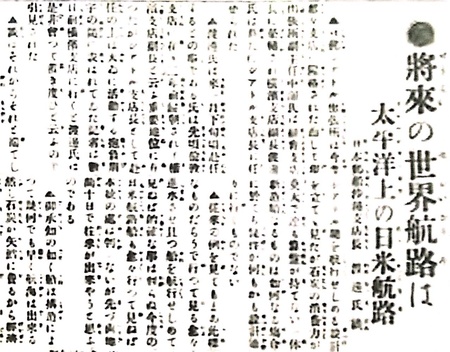
THE STAR SHIPS HIE-MARU AND HIKAWA-MARU
After 1930, Hie-maru, Hikawa-maru, and Heian-maru became the three major ships to travel the Seattle Route.
“Captain Takahashi’s Celebratory 100th Traversing of the Pacific Ocean” (From Nov. 30, 1934 issue)
“Captain Takahashi’s navigation of Hie-maru this time marked his 100th traversing of the Pacific Ocean. This follows Captain Yamaguchi’s 100th traverse celebration the other day. Captain Takahashi held a private celebration at home. It is easy to say that he has crossed the ocean 100 times. However, the fact that it usually takes two weeks to cross the ocean these days makes the frequency of his (round-trip) journeys total seven times a year. He is immersed in the deep blueness of the sky and the ocean day after day, spending 21 days at home out of the whole year. His record is simply admirable.
‘You have to be thick-skinned like me if you want to be a sailor. I’ve been a bit absent-minded since I was young, so I guess that worked out for the better,’ said the captain, showing his humbleness...As for my record on the Pacific Ocean, I would say that it has become my home ever since I crossed it on a training ship in 1909. Starting with my very first journey on Kitano-maru after I graduated from from Tokyo Shosen (Tokyo Merchant Shipping School) in 1910, I’ve been traveling back and forth on Aki-maru, Kaga-maru, and Mishima-maru. I’ve never counted my trips before, but it turns out that this is my 100th... I’ve done it 26 times on just the Hie-maru alone. Being the kind of ocean that it is, which usually gets rough and stormy, I have no (specific) memories or adventures to recall on the North Pacific Ocean.”
“Hikawa-maru to Arrive in Port Tomorrow Morning through the Rough Weather on the Pacific Ocean” (From the Dec. 26, 1934 issue)
“NYK’s Hikawa-maru is expected to arrive in port tomorrow morning, yet the weather on the Pacific Ocean has been rough for the past few days. The radio contact we received around the 20th reported a severe storm on the ocean and the English ship Penrose(?) was wrecked, with its control destroyed 1,700 miles from Seattle. A lifeboat is seemingly unable to move due to the waves and the safety of 40 crew members is at stake.
Expected to arrive in port tomorrow on the 27th, the Hikawa-maru kept running adeptly outside the storm area, but the ship is said to have passed Victoria this morning, heading straight to its last wharf directly through the storm yesterday evening. Yet arriving in port tomorrow will reportedly be no problem. Hikawa-maru will be the last ship from Japan to arrive this year.”
“NYK’s Hikawa-maru Arrives in Port in Seattle This Morning” (From the Dec. 27 issue)
“As the last ship to Seattle this year, NYK’s Hikawa-maru arrived in port this morning. Fumitaro Kaneko was the captain. Passengers were as follows: First-class (passenger names), second-class…, third-class….”
On the bottom of the same page in the same issue was a note titled “Personages Arriving” as follows:
“On Hikawa-maru which arrived in port this morning were Yoshinori Otsuka (Oji Paper Co.), Hisae Takahara (Lieutenant Commander of Kure, a city near Hiroshima), Yuji Yamada (Mitsui & Co., Ltd.), and others.”
The North American Times reported the name of every single passenger each time a ship from Japan arrived in Seattle.
Heian-maru
My father Atae was a Nisei who was born in Seattle in 1914, but he returned to Japan in 1929 when his father Yoemon passed away. In 1936, he revisited Seattle and returned to Japan in 1941, taking the Heian-maru both ways. This is how he described his experience.
“On every two-week trip by ship, we spent at least one day on an extreme rough sea and the ship shook hard. We faced waves as high as 10 meters trying to wreck our ship, but we managed to dodge side waves and navigate through the waves. Our ship could have overturned if directly hit by the side waves. Because of the huge sway, almost everyone got seasick and couldn’t get out of bed. I was fine, and when I went to the dining room at dinner time, which was always full of passengers, I saw no one.”
Hie-maru, Hikawa-maru, and Heian-maru, the ships that sailed the Seattle Route, were of extreme high quality that ensured safe passage through rough waves in severe storms.
The 50th Anniversary of Nippon Yusen
“Congratulatory Telegram to Yusen Kaisha” (From the October 1, 1935 issue)
“The Japanese Association of North America sent a congratulatory telegram to Nippon Yusen Kaisha, scheduled to arrive at noon on October 1, on the day of the company’s 50th anniversary.”
“Next Year Marks the 40th Anniversary of Miike-maru’s Arrival in Seattle” (From the October 2, 1935 issue)
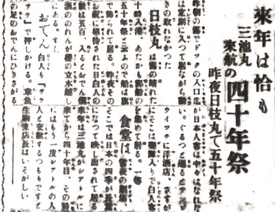
―The 50th anniversary celebrated on Hie-maru last night―
“Hie-maru, which had been stuck at the entrance of the dock due to the thick fog from yesterday morning, arrived at the port at 10 after the fog cleared. The ship is decorated with flags to celebrate Yusen’s 50th anniversary. The number of Caucasians invited to the festivity last night was 500. Upon entering, we can see the noren curtain with pictures of oden and warmed sake across the cherry blossom tree....The next year marks the 40th anniversary of Miike-maru’s first arrival in Seattle, and branch manager Ikoma is busy planning another gathering with people in Seattle for when the time comes.”
Supporting the development of Seattle, the Seattle Route was invaluable to the Nikkei people, connecting Seattle to their dear homeland of Japan.
In the next part, I will introduce articles about the growth of barbershop businesses owned by Japanese residents in Seattle.
Reference:
Kaigai Ryoko Annai-sha (Foreign travel guide), Beikoku ryokou annai (Travel Guide to the U.S.), 1927.
Kojiro Takeuchi, Beikoku Seihokubu Nihon Imin-shi (History of Japanese Immigrants in the Northwestern United States), Taihoku Nippo-sha, 1929.
Nippon Yusen Kabushiki Kaisha, eds. Nihon Yusen 50 nenshi (50 Years History of Nippon Yusen), 1935.
*The English version of this series is a collaboration between Discover Nikkei and The North American Post, Seattle’s bilingual community newspaper. This article was originally publishd on May 14, 2022 in The North American Post and is expanded for Discover Nikkei.
© 2022 Ikuo Shinmasu


